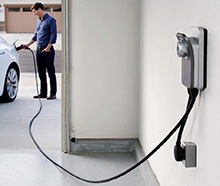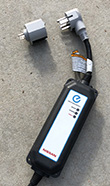 ChargePoint Charging Station
ChargePoint Charging Station  Nissan Portable Charging Cable
Nissan Portable Charging Cable
Additional information on home charging for Multi-Unit Residential Buildings (MURBs) is available here.
Level 1 Charging
All electric vehicles can be recharged using a standard 120V electrical outlet (level 1 charging), but it will usually take too long for convenient use at home and will only be used elsewhere when no other option is available.
Level 2 Charging
Most owners prefer to cut the recharging time dramatically by installing a 240V outlet (level 2 charging) in their garage or carport. A charging device (called an EVSE) plugs into the 240V outlet at one end and into the vehicle on the other. The most common plug type for the 240V outlet is a NEMA 14-50 connector. It can be used on circuits up to 50 amps.
The most common plug type for the vehicle up until now has been the J1772 connector. However the Tesla NACS connector is now being adopted by most major vehicle manufacturers.
How fast the vehicle charges generally depends on:
- how much power is available on the circuit supplying the 240V outlet;
- The EVSE's ability to output that power to the vehicle;
- the vehicle's ability to accept that power.
The EVSE can use 80% of the circuit breaker's amperage rating:
- 16 amps on a 20 amp circuit;
- 24 amps on a 30 amp circuit;
- 32 amps on a 40 amp circuit;
- 40 amps on a 50 amp circuit;
- 48 amps on a 60 amp circuit.
Most owners install a 32 amp EVSE on a 40 amp circuit that can output between 6.6 kW and 7.7 kW which can be accepted by most vehicles including all of those on the list of electric vehicles.
If it is only possible to install a 16 amp EVSE on a 20 amp circuit that outputs between 3.3 kW and 3.8 kW, and if the vehicle is driven around 60 km a day and is plugged in every day, then it will be fine for overnight charging even though it will take twice as long to charge (between 4 and 5 hours).
A portable EVSE (image above) is simply a long cable with a small electronic box in the middle. It can be left plugged into the outlet and hung on a hook or unplugged and taken on a trip. Most manufacturers supply a 120V portable EVSE with every vehicle.
Several manufacturers (e.g. Audi, BMW, Nissan and Tesla) either supply as standard equipment or sell a portable 240V EVSE that can be used on either a 120V or 240V circuit using an adapter for the plug.
The other option is a wall mounted EVSE (image above) which is similar, but has a larger electronic box that is permanently mounted on the wall near the outlet and is left plugged in. There are also wall mounted models that are hard wired directly into the electrical panel rather than plugged in, but it requires an electrician to remove them if you move.
The first step is to determine how much power is available in the electrical panel. If there is only 100 amps available in the electrical panel and the home uses an electric stove, electric clothes dryer and/or electric water heater, then it may be necessary to use a 16 amp charging station on a 20 amp circuit breaker or install a device which cuts power to the charging station when necessary. The cost of such devices is in the $1,000 range which should be compared to the cost of increasing the size of the power entrance to the home.
One device is an electrical load switch, such as the Load Miser, that allows the charging station and an appliance like a stove to share one circuit. Power to the charging station is cut if the stove is turned on. This can work well, especially if the vehicle charging takes place overnight.
The NeoCharge Dual-Car Smart Splitter costs $674 and allows you to run two level 2 chargers from one 240V outlet. It automatically switches to the second vehicle when the first vehicle has finished charging. If the chargers can be set to consume half the available current then it will charge both vehicles simultaneously. There is another version of the device that will share the outlet with an appliance rather than a second vehicle.
Another device is an energy management system, such as the Thermolec DCC-10, that monitors the total power consumption of the home and cuts power to the charging station when it gets too high and then restores power to the charging station when there is sufficient power available.
The cost of a 240V EVSE can vary widely and the costs specified below have been changing frequently. More expensive models have internet connectivity. Most electric vehicles come with smartphone software that remotely monitors charging through communication with the vehicle rather than the EVSE. An EVSE that requires hard wiring to the electrical panel rather than a plug to a 240V outlet can be costly to relocate if you move. Although hardwiring may be necessary in an outside location open to the elements, some plug-in models are weatherproof and use a 240V outlet in a weatherproof housing.
The following models have a J1772 connector unless otherwise indicated. The most versatile option is to use a portable 240V EVSE, either 32 amp or 40 amp with a NEMA 14-50 connector, especially if one is supplied with the vehicle. If it isn't, our recommendations are:
The Lectron 40 amp model is available from Lectron on sale at $363 with a 16 ft. cable.
The Pion Power Flex Charger is available from Pion Power on sale at $260 (32 amp) or $330 (40 amp). Cable length is 22 ft. The charger has network connectivity and an app.
The Canadian made Grizzl-E Mini is available for $600 with a 3-year warranty. It can be set from 7 amps to 40 amps. Cable length is 25 ft. It is also available at the same price with an NACS connector.
The AmazingE FAST weatherproof model (made by Clipper Creek) available from Sun Country Highway for $699 (40 amp). Cable length is 25 ft.
The Tesla Corded Mobile Connector has an NACS connector and a 20 ft. cable. It is available for $380
There are many cheaper and/or higher amperage portable models available from other manufacturers on Amazon, but there have been concerns about reliability and safety for some of them.
There are many wall mounted EVSEs available. If you are fortunate enough to have enough power available in your electrical panel for a 50 amp or 60 amp circuit then a wall mounted model is recommended for safety reasons. It will likely have to be hardwired on a 60 amp circuit. The frequently recommended units listed below plug into a NEMA 14-50 240V outlet and will handle at least 32 amp output on a 40 amp circuit.
The cheapest reliable wall mounted option is the Canadian made weatherproof Grizzl-E Classic plug-in, which can be set from 16 amps to 40 amps with a 25 ft. cable and is available for $500 with a 3-year warranty.
The Sun Country Highway 32 amp plug-in EV40P (made by Clipper Creek) with a 25 ft. cable is available for $899 with a 3-year warranty.
The ChargePoint Home Flex plug-in, which can be set from 16 amps to 50 amps, is available from Amazon for $709. The charger has network connectivity and an app.
The Canadian made weatherproof FLO plug-in Home X3 can be set from 6 amps to 50 amps with a 25 ft. cable and is available for $849 with a 5-year warranty. It is also available at the same price with an NACS connector.
The hardwired 48 amp Tesla Wall Connector has an NACS connector and a 24 ft. cable. It is available for $580. The similar Tesla Universal Wall Connector also comes with a J1772 adapter and is available for $760.
If a hardwired model is required, there are many more to choose from in addition to the hardwired versions of the above charging stations.
Recent quotations for installation by a professional electrician in a garage not far from the electrical panel: labour $550, materials $150 - $200, permit $100 for a total cost of $800 - $850 plus GST. Get several quotes. We can recommend an installation electrician if you send an Information Request below.
Level 2 Charging Government Rebates
Most electric vehicles can be programmed to charge in the middle of the night when demand on the electric grid is very low making surplus power available. For this reason, we are encouraging governments to put more funding into home charging rather than public charging which is mostly done during the day.
The BC Government rebate for the installation of a home EVSE in single family dwellings is 50% of the cost to a maximum of $350. Almost all of the EVSEs listed above qualify except the Tesla models. Single family homes include duplexes and triplexes where the residence has a dedicated adjacent parking space. Townhouses are included with Multi-Unit Residential Buildings (MURBs).
Note that the installation of only an electrical outlet in a single family home is not eligible for reimbursement. However, it becomes eligible if you also purchase an eligible EVSE.
A detailed description of the program is available here. BC Hydro is administering the reimbursement process on behalf of the government. The reimbursement form and procedures are available here.
There is an additional $250 rebate from BC Hydro if the EVSE purchased is the ChargePoint Home Flex.
Information on the BC Government charging incentive for Multi-Unit Residential Buildings (MURBs) and workplaces is available here.
Level 3 Charging
Level 3 DC fast charging at 400V and higher can recharge most vehicles to at least 80% of capacity in around a half hour. This is beyond the capability of home charging stations and requires a public station with direct access to the electrical grid. There are three types of level 3 charging connectors: Tesla Supercharger (also known as NACS) which will also be used by Ford, GM and many other manufacturers starting with 2025 models, CHAdeMO used by some Japanese manufacturers and SAE Combo (also known as CCS) used by other U.S. and German manufacturers. It is anticipated that the NACS standard will be dominant in North America.